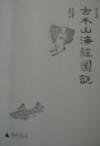
Ma, Changyi. Guben Shanhaijing Tushuo (An Interpretation to Illustrations in Ancient Versions of Shanhaijing). Originally published by Shandong Huabao Publishing House, Ji’nan, 2001. Reprinted by Guilin: Guangxi Shifan Daxue Press, 2007; Taibei: Gaiya Wenhua Publishing House, 2009.
Ma, Changyi. Quanxiang Shanhaijingtu Bijiao (A Through Comparison to Illustrations in Shanhaijing). Beijing: Xueyuan Publishing House, 2003.
Reviewed by Lihui Yang, professor of folklore, Beijing Normal University, Beijing
Among various Chinese classics, Shanhaijing (or The Classic of Mountains and Seas, ca. fourth century bc to the early period of second century bc) is a notable one. It is respected by many scholars as an important book in ancient Chinese mythology studies, or even as an encyclopedia of ancient China. During the past 2,000 years, it has attracted numerous studies. However, the illustrations in the book have never received through investigation, even though it is commonly agreed that the book was originally written with both characters and drawings, or even more, that it was a book explaining mythical ancient icons with written texts produced later.
Ma Changyi’s two recent books, Guben Shanhaijing Tushuo (An Interpretation of Illustrations in Ancient Versions of the Shanhaijing, briefly called as An Interpretation in the following), and Quanxiang Shanhaijingtu Bijiao (A Thorough Comparison of The Illustrations in Shanhaijing, briefly as A Comparison), establish the first monumental study of the illustrated Shanhaijing. They enrich the limited perspective of approaching the Shanhaijing from written textual analysis, thus broadening the scope of Shanhaijing studies.
As one of the outstanding Chinese mythologists, Ma has concentrated her research interest on the illustrated Shanhaijing for more than ten years. She has spent considerable time and money, collecting those precious illustrations scattered in various ancient versions of the Shanhaijing in mainland China, Taiwan, Japan, Russia, France, America, and elsewhere. By reframing the study as a narrative tradition combining both iconology and literal texts, the author tries to discover the interrelationship between the illustrations and relevant written texts, to further explore the illustrated mythological world among archaic Chinese.
In An Interpretation, Ma selected 1,000 drawings of spirits, monsters, and mythological animals from 2,000 illustrations she found in 10 reprinted versions from the Ming and Qing dynasties, and then compared them with their counterparts and the related written texts. Based on this book, A Comparison further enlarged the scope to 14 versions, including one reprinted in Japan in about the 17th century to the middle of 19th century.
New perspectives and materials often stimulate novel thoughts. In Ma’s two books, inspiring arguments and deep insights can readily be found on many pages. For example, the author maintains that there was an intimate connection between the production of illustrated Shanhaijing and the iconology narrative tradition, which can easily be found in cliff paintings, bronze paintings, and funeral stone carvings especially prevailing in and before Han dynasty. In addition, in many versions of the book, the mythological bird Bifang is often described in written texts as “with one human’s face and one foot.” Many interpreters of the book, such as Wu Chengzhi, Hao Yixing, Yuan Ke, all agree that the recording is not accurate and the word “human-faced” is a misprint. But in Ma’s collection, Bifang does appear in one version with one foot and a man’s face. Therefore, she deduced that the literal recoding about Bifang probably is correct, while those interpreters above may have reached incorrect conclusions because they did not see enough illustrations about this bird.
The book further strengthens the claim that the Shanhaijing was written for the use of shamanism. This point would be more persuasive, however, if it receives more theoretical support and empirical evidence.
